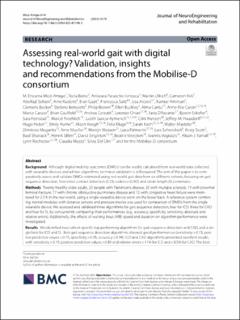Assessing real-world gait with digital technology? Validation, insights and recommendations from the Mobilise-D consortium
| dc.contributor.author | Micó-Amigo, M. Encarna | |
| dc.contributor.author | Bonci, Tecla | |
| dc.contributor.author | Paraschiv-Ionescu, Anisoara | |
| dc.contributor.author | Ullrich, Martin | |
| dc.contributor.author | Kirk, Cameron | |
| dc.contributor.author | Soltani, Abolfazl | |
| dc.contributor.author | Küderle, Arne | |
| dc.contributor.author | Gazit, Eran | |
| dc.contributor.author | Salis, Francesca | |
| dc.contributor.author | Alcock, Lisa | |
| dc.contributor.author | Aminian, Kamiar | |
| dc.contributor.author | Becker, Clemens | |
| dc.contributor.author | Bertuletti, Stefano | |
| dc.contributor.author | Brown, Philip | |
| dc.contributor.author | Buckley, Ellen | |
| dc.contributor.author | Cantu, Alma | |
| dc.contributor.author | Carsin, Anne-Elie | |
| dc.contributor.author | Caruso, Marco | |
| dc.contributor.author | Caulfield, Brian | |
| dc.contributor.author | Cereatti, Andrea | |
| dc.contributor.author | Chiari, Lorenzo | |
| dc.contributor.author | D’Ascanio, Ilaria | |
| dc.contributor.author | Eskofier, Bjoern | |
| dc.contributor.author | Fernstad, Sara | |
| dc.contributor.author | Froehlich, Marcel | |
| dc.contributor.author | Garcia-Aymerich, Judith | |
| dc.contributor.author | Hansen, Clint | |
| dc.contributor.author | Hausdorff, Jeffrey M. | |
| dc.contributor.author | Hiden, Hugo | |
| dc.contributor.author | Hume, Emily | |
| dc.contributor.author | Keogh, Alison | |
| dc.contributor.author | Kluge, Felix | |
| dc.contributor.author | Koch, Sarah | |
| dc.contributor.author | Maetzler, Walter | |
| dc.contributor.author | Megaritis, Dimitrios | |
| dc.contributor.author | Mueller, Arne | |
| dc.contributor.author | Niessen, Martijn | |
| dc.contributor.author | Palmerini, Luca | |
| dc.contributor.author | Schwickert, Lars | |
| dc.contributor.author | Scott, Kirsty | |
| dc.contributor.author | Sharrack, Basil | |
| dc.contributor.author | Sillén, Henrik | |
| dc.contributor.author | Singleton, David | |
| dc.contributor.author | Vereijken, Beatrix | |
| dc.contributor.author | Vogiatzis, Ioannis | |
| dc.contributor.author | Yarnall, Alison J. | |
| dc.contributor.author | Rochester, Lynn | |
| dc.contributor.author | Mazzà, Claudia | |
| dc.contributor.author | Del Din, Silvia | |
| dc.date.accessioned | 2023-10-24T14:25:24Z | |
| dc.date.available | 2023-10-24T14:25:24Z | |
| dc.date.created | 2023-06-30T09:19:17Z | |
| dc.date.issued | 2023 | |
| dc.identifier.citation | Journal of NeuroEngineering and Rehabilitation. 2023, 20 (1), . | en_US |
| dc.identifier.issn | 1743-0003 | |
| dc.identifier.uri | https://hdl.handle.net/11250/3098501 | |
| dc.description.abstract | Background Although digital mobility outcomes (DMOs) can be readily calculated from real-world data collected with wearable devices and ad-hoc algorithms, technical validation is still required. The aim of this paper is to comparatively assess and validate DMOs estimated using real-world gait data from six different cohorts, focusing on gait sequence detection, foot initial contact detection (ICD), cadence (CAD) and stride length (SL) estimates. Methods Twenty healthy older adults, 20 people with Parkinson’s disease, 20 with multiple sclerosis, 19 with proximal femoral fracture, 17 with chronic obstructive pulmonary disease and 12 with congestive heart failure were monitored for 2.5 h in the real-world, using a single wearable device worn on the lower back. A reference system combining inertial modules with distance sensors and pressure insoles was used for comparison of DMOs from the single wearable device. We assessed and validated three algorithms for gait sequence detection, four for ICD, three for CAD and four for SL by concurrently comparing their performances (e.g., accuracy, specificity, sensitivity, absolute and relative errors). Additionally, the effects of walking bout (WB) speed and duration on algorithm performance were investigated. Results We identified two cohort-specific top performing algorithms for gait sequence detection and CAD, and a single best for ICD and SL. Best gait sequence detection algorithms showed good performances (sensitivity > 0.73, positive predictive values > 0.75, specificity > 0.95, accuracy > 0.94). ICD and CAD algorithms presented excellent results, with sensitivity > 0.79, positive predictive values > 0.89 and relative errors < 11% for ICD and < 8.5% for CAD. The best identified SL algorithm showed lower performances than other DMOs (absolute error < 0.21 m). Lower performances across all DMOs were found for the cohort with most severe gait impairments (proximal femoral fracture). Algorithms’ performances were lower for short walking bouts; slower gait speeds (< 0.5 m/s) resulted in reduced performance of the CAD and SL algorithms. Conclusions Overall, the identified algorithms enabled a robust estimation of key DMOs. Our findings showed that the choice of algorithm for estimation of gait sequence detection and CAD should be cohort-specific (e.g., slow walkers and with gait impairments). Short walking bout length and slow walking speed worsened algorithms’ performances. | en_US |
| dc.language.iso | eng | en_US |
| dc.publisher | BMC | en_US |
| dc.rights | Navngivelse 4.0 Internasjonal | * |
| dc.rights.uri | http://creativecommons.org/licenses/by/4.0/deed.no | * |
| dc.title | Assessing real-world gait with digital technology? Validation, insights and recommendations from the Mobilise-D consortium | en_US |
| dc.title.alternative | Assessing real-world gait with digital technology? Validation, insights and recommendations from the Mobilise-D consortium | en_US |
| dc.type | Peer reviewed | en_US |
| dc.type | Journal article | en_US |
| dc.description.version | publishedVersion | en_US |
| dc.source.pagenumber | 0 | en_US |
| dc.source.volume | 20 | en_US |
| dc.source.journal | Journal of NeuroEngineering and Rehabilitation | en_US |
| dc.source.issue | 1 | en_US |
| dc.identifier.doi | 10.1186/s12984-023-01198-5 | |
| dc.identifier.cristin | 2159677 | |
| cristin.ispublished | true | |
| cristin.fulltext | original | |
| cristin.qualitycode | 1 |

